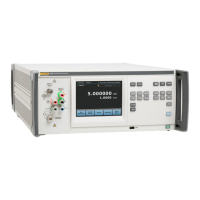Front Panel Operation
Basic Operation 4
4-19
Selecting Auto or Locked Range
When set to Auto Range, the Product ranges up or down and usually selects the
best range in which to measure a voltage. For measurements near top or bottom
of range, however, you may need to lock the range to keep the Product in the
desired range. When voltages >2.2 V are measured, lock the desired range
before applying the voltage for best performance. Auto Range is selected at
power-up and after a RESET.
To lock the Product range, touch the indicated range field at the top of the display
and note that the label changes to "LOCKED." You can also lock a range by
simply pushing one of the range select keys. All further measurements are taken
in the locked range until the range is reset to AUTO. Locking a range and
applying excessive voltage for that range does not damage the Product if the
voltage and current limits are within specification (1000 V dc or rms, and 200 mA
max). To place the Product back into Auto Range, touch the indicated range field
at the top of the display.
The Product input impedance is dependent on the range selected. For low
voltage ranges, 2.2 V and below, the Product has a high input impedance
minimizing errors associated with sources with higher impedances (such as the
5730A millivolt ranges which are 50 Ω). For higher voltage ranges, input
impedances as low as 50 kΩ are obtained. A temporary introduction of a 50 kΩ
load (which will occur during the Product auto-range) may affect a source
instrument. If the output voltage of a source instrument is affected more than
10 %, resulting from the Product auto-ranging, the Product will follow the source
voltage fluctuations. Because of the continual voltage fluctuations between the
range changes, a condition may arise where the instruments are not able to
settle to a stable state.
The 5205A and 5215A instruments provide an internal slew rate trip mechanism
that is affected by load fluctuations that occur during voltage transitions. The
5205A and 5215A instruments expect their loads to be stable during voltage
transitions. If the load voltage is not stable, a slew rate trip condition may occur. If
the slew rate monitor is triggered, the 5205A and 5215A will momentarily source
a low voltage and will try to apply the desired voltage again. As a result, a cyclic
pattern occurs and the Product auto-ranging tracks the source instrument and
appears to oscillate between ranges. Range lock the Product to the desired
range and then apply the voltage from either the 5205A or 5215A. This prevents
a cyclic auto-range condition between the 5790B and the 5205A or 5215A
instruments. When a 5205A is used as the boost amplifier for the 5700A, a slew
rate trip condition is avoided because the 5700A forces a controlled ramp to the
final voltage. Auto-ranging will then work as expected on the Product. Even so, it
is best to range lock the Product for best performance.

